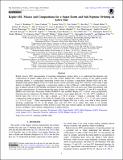Files in this item
Kepler-102 : masses and compositions for a super-Earth and sub-Neptune orbiting an active star
Item metadata
| dc.contributor.author | Brinkman, Casey L. | |
| dc.contributor.author | Cadman, James | |
| dc.contributor.author | Weiss, Lauren | |
| dc.contributor.author | Gaidos, Eric | |
| dc.contributor.author | Rice, Ken | |
| dc.contributor.author | Huber, Daniel | |
| dc.contributor.author | Claytor, Zachary R. | |
| dc.contributor.author | Bonomo, Aldo S. | |
| dc.contributor.author | Buchhave, Lars A. | |
| dc.contributor.author | Cameron, Andrew Collier | |
| dc.contributor.author | Cosentino, Rosario | |
| dc.contributor.author | Dumusque, Xavier | |
| dc.contributor.author | Martinez Fiorenzano, Aldo F. | |
| dc.contributor.author | Ghedina, Adriano | |
| dc.contributor.author | Harutyunyan, Avet | |
| dc.contributor.author | Howard, Andrew | |
| dc.contributor.author | Isaacson, Howard | |
| dc.contributor.author | Latham, David W. | |
| dc.contributor.author | López-Morales, Mercedes | |
| dc.contributor.author | Malavolta, Luca | |
| dc.contributor.author | Micela, Giuseppina | |
| dc.contributor.author | Molinari, Emilio | |
| dc.contributor.author | Pepe, Francesco | |
| dc.contributor.author | Philips, David F. | |
| dc.contributor.author | Poretti, Ennio | |
| dc.contributor.author | Sozzetti, Alessandro | |
| dc.contributor.author | Udry, Stéphane | |
| dc.date.accessioned | 2023-01-30T17:30:08Z | |
| dc.date.available | 2023-01-30T17:30:08Z | |
| dc.date.issued | 2023-02-01 | |
| dc.identifier | 283167136 | |
| dc.identifier | b7e861c6-dd97-4a64-a0f9-ebb615a2a6b1 | |
| dc.identifier | 85147219581 | |
| dc.identifier.citation | Brinkman , C L , Cadman , J , Weiss , L , Gaidos , E , Rice , K , Huber , D , Claytor , Z R , Bonomo , A S , Buchhave , L A , Cameron , A C , Cosentino , R , Dumusque , X , Martinez Fiorenzano , A F , Ghedina , A , Harutyunyan , A , Howard , A , Isaacson , H , Latham , D W , López-Morales , M , Malavolta , L , Micela , G , Molinari , E , Pepe , F , Philips , D F , Poretti , E , Sozzetti , A & Udry , S 2023 , ' Kepler-102 : masses and compositions for a super-Earth and sub-Neptune orbiting an active star ' , Astronomical Journal , vol. 165 , no. 2 , 74 . https://doi.org/10.3847/1538-3881/aca64d | en |
| dc.identifier.issn | 0004-6256 | |
| dc.identifier.other | Jisc: 867413 | |
| dc.identifier.other | publisher-id: ajaca64d | |
| dc.identifier.other | manuscript: aca64d | |
| dc.identifier.other | other: aas36633 | |
| dc.identifier.other | ORCID: /0000-0002-8863-7828/work/128097413 | |
| dc.identifier.uri | https://hdl.handle.net/10023/26857 | |
| dc.description | Funding: This material is based upon work supported by the National Science Foundation Graduate Research Fellowship under grant No. 1842402. C.L.B., L.W., and D.H. acknowledge support from National Aeronautics and Space Administration (grant No. 80NSSC19K0597) issued through the Astrophysics Data Analysis Program. D.H. also acknowledges support from the Alfred P. Sloan Foundation. K.R. acknowledges support from the UK STFC via grant No. ST/V000594/1. E.G. acknowledges support from NASA grant No. 80NSSC20K0957 (Exoplanets Research Program). | en |
| dc.description.abstract | Radial velocity (RV) measurements of transiting multiplanet systems allow us to understand the densities and compositions of planets unlike those in the solar system. Kepler-102, which consists of five tightly packed transiting planets, is a particularly interesting system since it includes a super-Earth (Kepler-102d) and a sub-Neptune-sized planet (Kepler-102e) for which masses can be measured using RVs. Previous work found a high density for Kepler-102d, suggesting a composition similar to that of Mercury, while Kepler-102e was found to have a density typical of sub-Neptune size planets; however, Kepler-102 is an active star, which can interfere with RV mass measurements. To better measure the mass of these two planets, we obtained 111 new RVs using Keck/HIRES and Telescopio Nazionale Galileo/HARPS-N and modeled Kepler-102's activity using quasiperiodic Gaussian process regression. For Kepler-102d, we report a mass upper limit Md < 5.3 M⊕ (95% confidence), a best-fit mass Md = 2.5 ± 1.4 M⊕, and a density ρd = 5.6 ± 3.2 g cm−3, which is consistent with a rocky composition similar in density to the Earth. For Kepler-102e we report a mass Me = 4.7 ± 1.7 M⊕ and a density ρe = 1.8 ± 0.7 g cm−3. These measurements suggest that Kepler-102e has a rocky core with a thick gaseous envelope comprising 2%–4% of the planet mass and 16%–50% of its radius. Our study is yet another demonstration that accounting for stellar activity in stars with clear rotation signals can yield more accurate planet masses, enabling a more realistic interpretation of planet interiors. | |
| dc.format.extent | 14 | |
| dc.format.extent | 2113759 | |
| dc.language.iso | eng | |
| dc.relation.ispartof | Astronomical Journal | en |
| dc.subject | QB Astronomy | en |
| dc.subject | QC Physics | en |
| dc.subject | 3rd-DAS | en |
| dc.subject | MCC | en |
| dc.subject.lcc | QB | en |
| dc.subject.lcc | QC | en |
| dc.title | Kepler-102 : masses and compositions for a super-Earth and sub-Neptune orbiting an active star | en |
| dc.type | Journal article | en |
| dc.contributor.sponsor | Science & Technology Facilities Council | en |
| dc.contributor.institution | University of St Andrews. School of Physics and Astronomy | en |
| dc.contributor.institution | University of St Andrews. St Andrews Centre for Exoplanet Science | en |
| dc.identifier.doi | 10.3847/1538-3881/aca64d | |
| dc.description.status | Peer reviewed | en |
| dc.identifier.grantnumber | ST/X002217/1 | en |
This item appears in the following Collection(s)
Items in the St Andrews Research Repository are protected by copyright, with all rights reserved, unless otherwise indicated.

